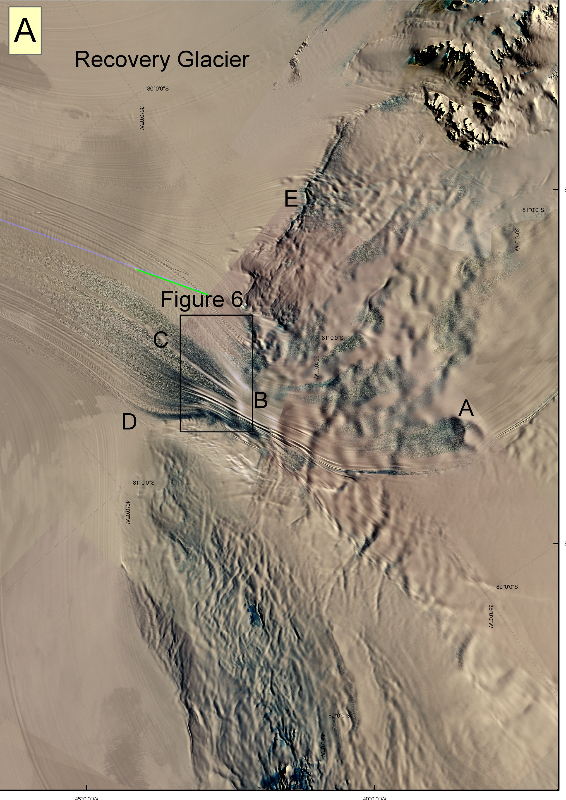The pattern of velocity across the surface of an ice stream is complex, and varies between ice streams. It is captured by surficial structures, such as crevasses and longitudinal flow structures (also known as flow stripes, flow lines, and streak lines)[20]. In places, they can be traced for > 100 km. They form on valley glaciers, outlet glaciers and ice streams, all flowing at a variety of velocities. Longitudinal structures are typically developed parallel to the margins of glacier flow units.
Surface Structures
Glasser and Gudmundsson (2012)[20] have mapped surface structures on a number of Antarctic glaciers.
There are three key hypotheses for longitudinal surface structure formation[20]:
- They form as a result of lateral compression in topographic situations where glaciers flow from wide accumulation basins into a narrow tongue.;
- They form where two glacier tributaries converge, and are associated with shear margins between flow units;
- They are the surface expression of subglacial bed perturbations created during rapid basal sliding.
Glasser and Gudmundsson 2012[20] make the following key observations regarding longitudinal surface structures on Antarctic glaciers:
- They are common features on Antarctic glaciers and ice streams, forming at a variety of scales from entire glacier catchments to individual small valley glaciers;
- At confluences, larger glaciers “pinch out” structures where they meet smaller tributary glaciers;
- The structures can be followed from cirque headwalls to glacier snouts and are continuous;
- Longitudinal surface structures sometimes intensify in zones of lateral compression;
- Longitudinal structures are more closely spaced at flow-unit boundaries than away from these boundaries.
- They are most prominent where ice flow is convergent, but can also be maintained where flow diverges;
- They start abruptly, particularly behind bedrock obstacles and nunataks;
- They can turn more than 90° without interruption or increased lateral compression;
- They are sometimes, but not always, associated with surface debris.
How do they develop?
Glasser and Gudmundsson suggest that these surface structures can develop in two main situations: within glacier flow units, and where there is convergent flow around nunataks of glacier confluence zones. Development within flow units is relatively well understood and derives from basal perturbations on the ice-stream surface[21].
Where these structures start abruptly, they form in areas with rapid longitudinal extension, suggesting that extensional flow can explain these structures. The confluence of two glaciers or flow units, for example, results in strong transverse convergence and longitudinal extension.




